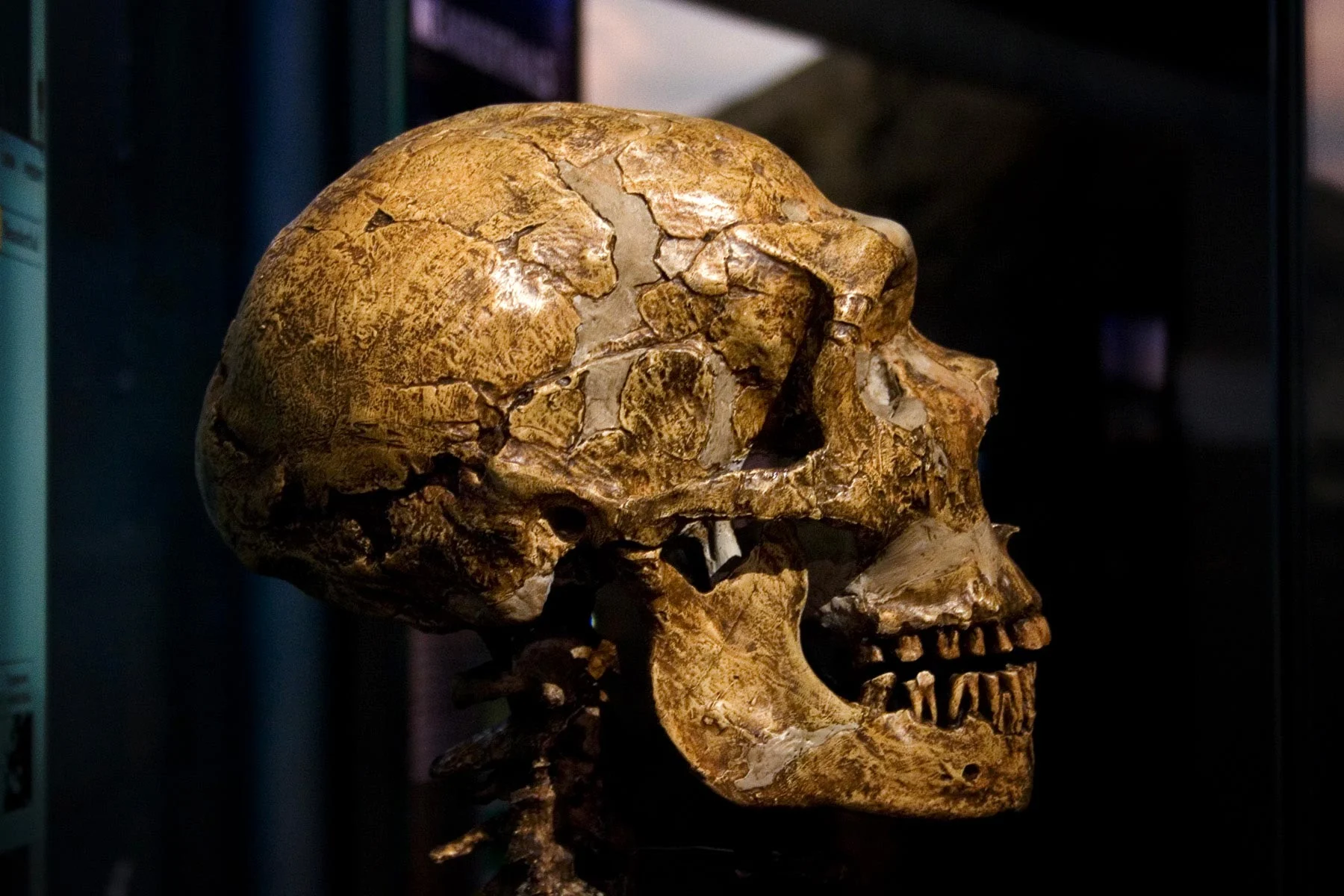The quest to unravel the origins of the human race has captivated researchers and academics for centuries. Extensive investigations have led to a resounding and incontrovertible revelation: Africa serves as the birthplace of humanity. Often heralded as the cradle of humankind, this continent has yielded pivotal discoveries in the realm of human evolution.
Notably, the oldest known skeletal remains of anatomically modern humans, Homo sapiens sapiens, were unearthed in East Africa, specifically at the Omo Kibish site in Ethiopia, dating back approximately 195,000 years. Furthermore, the discovery of pre-human fossils spanning 4 to 5 million years across Africa underscores the continent’s indispensable role in the overarching narrative of evolution. Among these ancient precursors is Australopithecus ramidus, whose existence dates back at least 4.4 million years. This article delves into these momentous discoveries, meticulously examining their profound significance and the compelling narrative they weave about our collective ancestry.
The Discovery of Omo Remains
In 1967, a team headed by the esteemed paleoanthropologist Richard Leakey made a groundbreaking discovery in the Omo River region of southwestern Ethiopia. During their excavation, they uncovered the Omo remains, which included several bones belonging to two individuals. Through radiometric dating, scientists determined that these remains are approximately 195,000 years old, making them the oldest known fossils of anatomically modern humans. This discovery at Omo Kibish has been pivotal in reshaping our understanding of human origins, providing compelling evidence that Homo sapiens originated in Africa.
The Omo remains exhibit important anatomical traits that differentiate modern humans from earlier hominins. These traits include a prominent forehead, diminished brow ridge, and a smaller, more rounded skull. These distinctive features signify a significant evolutionary development that led to the emergence of modern humans.
The Genetic Evidence Supporting African Origins
Genetic research provides compelling evidence supporting the African origins of modern humans. Comprehensive analyses of mitochondrial DNA (mtDNA) and Y-chromosome DNA have consistently revealed that the highest genetic diversity is found among African populations. This rich genetic diversity suggests an extensive period of human habitation in Africa, as genetic variations accumulate gradually over time. The notion of a “mitochondrial Eve,” a common maternal ancestor who lived in Africa around 150,000 to 200,000 years ago, is in line with the findings from the Omo region, thus reinforcing the theory that modern humans first emerged on this continent before dispersing to other parts of the world.
Pre-Human Ancestors: The Australopithecines
The Omo remains, discovered in Ethiopia, are the earliest known Homo sapiens and provide valuable insights into our evolutionary history. However, the lineage that ultimately led to modern humans has much deeper roots in Africa. One of the most important early hominins is Australopithecus ramidus, also known as Ardipithecus ramidus, which lived approximately 4.4 million years ago and played a crucial role in our evolutionary chain.
Discovered in Ethiopia in the early 1990s by a team led by Tim White, Ardipithecus ramidus, affectionately known as Ardi, offered significant revelations about early hominin behavior and physical characteristics. The most complete specimen, Ardi, displayed a unique blend of primitive and advanced traits. Despite having a small brain similar to that of modern chimpanzees, Ardi exhibited bipedalism, walking upright on two legs. This key adaptation is a defining feature of hominins and represents a significant milestone in our evolutionary history.
The Significance of Australopithecus
Australopithecus, a genus that emerged around 4 million years ago, persisted until about 2 million years ago. One of the most well-known australopithecine specimens is Australopithecus afarensis, famously represented by the iconic skeleton known as “Lucy.” Discovered in 1974 by Donald Johanson and his team in the Awash Valley of Ethiopia’s Afar Depression, Lucy’s skeleton is estimated to be around 3.2 million years old.
Lucy’s discovery provided profound insights into early human evolution. Her anatomy revealed that Australopithecus afarensis was capable of both climbing trees and walking upright, indicating a versatile lifestyle that likely facilitated survival in various environments. Additionally, Lucy’s relatively small brain, compared to modern humans, sheds light on the gradual nature of brain evolution in the hominin lineage. This evidence has significantly contributed to our understanding of human ancestors and their evolutionary adaptations.
The Evolutionary Journey: From Australopithecus to Homo
The emergence of the Homo genus from Australopithecus represents a pivotal moment in the story of human evolution. This significant transition is characterized by notable advancements in brain size, tool usage, and social behavior. Among the earliest members of the Homo genus is Homo habilis, often referred to as the “handyman” owing to its association with stone tools. Discovered by Louis and Mary Leakey at Olduvai Gorge in Tanzania, Homo habilis thrived approximately 2.4 to 1.4 million years ago.
Notably, Homo habilis possessed a larger brain compared to its australopithecine predecessors, indicating a substantial leap in cognitive abilities. Moreover, evidence suggests that Homo habilis exhibited more sophisticated tool-making techniques. The tools associated with this species, categorized as part of the Oldowan toolkit, were relatively basic in design but represented a significant technological advancement. It is believed that these tools conferred adaptive advantages in tasks such as acquiring food and processing animal carcasses.
Homo Erectus: The Pioneer of Human Migration
Homo erectus, an important species in human evolutionary history, appeared approximately 1.9 million years ago. This species is distinguished by its remarkable brain expansion and increase in body size. Notably, Homo erectus holds the distinction of being the first hominin to venture out of Africa, spreading into Asia and Europe. This migration represents a pivotal moment in human evolution, showcasing the adaptability and resilience of early humans as they navigated and thrived in different environments.
One of the most renowned Homo erectus specimens is “Turkana Boy,” unearthed near Lake Turkana in Kenya by Richard Leakey and Kamoya Kimeu. The nearly complete skeleton of Turkana Boy, estimated to be around 1.6 million years old, has provided invaluable insights into the physical attributes and development of Homo erectus. This species displayed more human-like body proportions, featuring elongated legs suitable for covering long distances on foot and possibly running, which likely aided their successful migration across diverse terrains.
Homo Sapiens: The Dawn of Modern Humanity
The story of human evolution reaches its culmination with the appearance of Homo sapiens, our species. The earliest known fossils of modern humans, found in Omo, provide valuable insights into our evolutionary past. However, other significant discoveries, such as the Herto fossils from Ethiopia dating back approximately 160,000 years, also play a crucial role in shaping our understanding of the development of our species. These fossils exhibit a combination of features that bridge the gap between archaic humans and modern Homo sapiens, contributing to a more comprehensive picture of our evolutionary journey.
The emergence of Homo sapiens is characterized by the development of advanced tools, artistic expression, and symbolic behavior, representing a significant departure from earlier hominins. This newfound ability to create and utilize complex tools, develop intricate language systems, and form sophisticated social structures empowered Homo sapiens to thrive in diverse environments and eventually populate different parts of the world.
The Out-of-Africa Hypothesis
The “Out-of-Africa” hypothesis is a well-supported model that explains the migration of Homo sapiens from Africa to other continents. According to this theory, modern humans originated in Africa and began their migration out of the continent approximately 60,000 to 70,000 years ago. This hypothesis is backed by genetic evidence, which demonstrates that non-African populations carry genetic markers indicating a shared African ancestry.
As Homo sapiens ventured out of Africa, they encountered and interbred with other hominin species. For instance, in Europe, they interacted with Neanderthals, while in Asia, they intermingled with Denisovans. These interbreeding events significantly contributed to the genetic diversity observed in modern human populations today.
Africa’s Role in Human Evolution
The study of human evolution heavily relies on fossil evidence, but Africa’s significance in this field goes beyond just skeletal remains. The continent’s wide range of environments, including savannas and forests, offered diverse landscapes that were crucial for various evolutionary adaptations. Moreover, Africa’s climatic changes over millions of years exerted evolutionary pressures that influenced the development of early hominins.
Africa’s impact on human evolution is further demonstrated through the rich cultural and technological advancements that originated on the continent. For instance, the earliest known instances of symbolic art, such as the intricate engravings found in South Africa’s Blombos Cave, date back approximately 75,000 years and underscore the cognitive and cultural progress of early Homo sapiens.
The evidence shows that humans started in Africa. Fossils like the Omo remains and others found in Africa tell the story of how we evolved. From early hominins like Ardipithecus ramidus and Australopithecus afarensis to modern humans, Africa has been really important in our evolution.
Delving into our African roots is not only a matter of scientific interest; it holds profound implications for how we perceive ourselves and our position in the global tapestry. Acknowledging that all humans share a common origin nurtures a sense of unity and interconnectedness that transcends geographical and cultural divides. Our shared African heritage stands as a testament to the resilience, adaptability, and creativity that characterize the human species.
We are still learning about our ancient history. It’s important to remember that we are always discovering new things about how humans evolved. Every discovery adds to our understanding of our identity and where we come from. Africa has a lot of fossils and cultural history that can help us learn more about how humans began and developed.
Reference
- Stringer, C. (June 2003). “Human evolution: Out of Ethiopia“. Nature, 423(6941): 692–693, 695. Bibcode: 2003Natur.423..692S. doi:10.1038/423692a. PMID 12802315. S2CID 26693109.
- Stringer, C. (2012). Lone Survivors: How We Came to Be the Only Humans on Earth. Henry Holt and Company. p. 26. ISBN 978-1429973441 – via Google Books.
- Wolpoff, M. H., Hawks, J., & Caspari, R. (May 2000). “Multiregional, not multiple origins” (PDF). American Journal of Physical Anthropology, 112(1): 129–136. doi:10.1002/(SICI)1096-8644(200005)112:1<129::AID-AJPA11>3.0.CO;2-K. hdl:2027.42/34270. PMID 10766948.
- Mafessoni, F. (January 2019). “Encounters with archaic hominins”. Nature Ecology & Evolution, 3(1): 14–15. doi:10.1038/s41559-018-0729-6. PMID 30478304. S2CID 53783648.
- Villanea, F. A., & Schraiber, J. G. (January 2019). “Multiple episodes of interbreeding between Neanderthal and modern humans“. Nature Ecology & Evolution, 3(1): 39–44. doi:10.1038/s41559-018-0735-8. PMC 6309227. PMID 30478305.
- University of Huddersfield. (20 March 2019). “Researchers shed new light on the origins of modern humans – The work, published in Nature, confirms a dispersal of Homo sapiens from southern to eastern Africa immediately preceded the out-of-Africa migration“. EurekAlert!. Retrieved 23 March 2019.
- Rito, T., Vieira, D., Silva, M., Conde-Sousa, E., Pereira, L., Mellars, P., et al. (March 2019). “A dispersal of Homo sapiens from southern to eastern Africa immediately preceded the out-of-Africa migration“. Scientific Reports, 9(1): 4728. Bibcode: 2019NatSR…9.4728R. doi:10.1038/s41598-019-41176-3. PMC 6426877. PMID 30894612.
- Scerri, E. M., Chikhi, L., & Thomas, M. G. (October 2019). “Beyond multiregional and simple out-of-Africa models of human evolution“. Nature Ecology & Evolution, 3(10): 1370–1372. Bibcode: 2019NatEE…3.1370S. doi:10.1038/s41559-019-0992-1. hdl:10400.7/954. PMID 31548642. S2CID 202733639.
- Scerri, E. M., Thomas, M. G., Manica, A., Gunz, P., Stock, J. T., Stringer, C., et al. (August 2018). “Did Our Species Evolve in Subdivided Populations across Africa, and Why Does It Matter?”. Trends in Ecology & Evolution, 33(8): 582–594. doi:10.1016/j.tree.2018.05.005. PMC 6092560. PMID 30007846.







